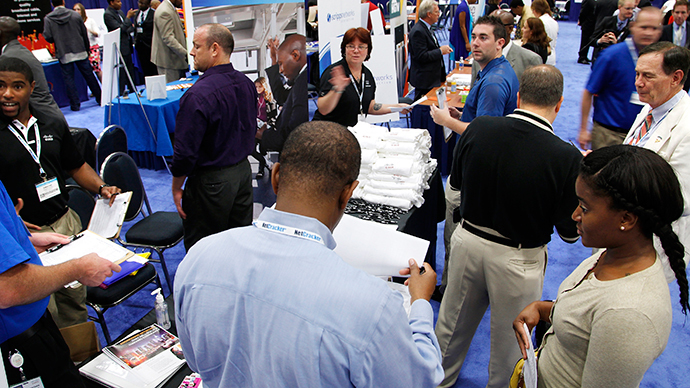33% of Americans out of workforce, highest rate since 1978

The number of Americans aged 16 and older not participating in the labor force hit 92,898,000 in February, tying December’s record, according to data released by the Bureau of Labor Statistics (BLS).
Over the longer trend, the labor force participation rate was between 62.9 percent and 62.7 percent from April 2014 through February, and has been hovering around 62.9 percent or lower in 13 of the 17 months since October 2013, the BLS data revealed.
To put it another way, when President Obama took office in January 2009, there were 80,529,000 Americans who were not participating in the workforce, which means that 12,369,000 US citizens have left the workforce since then.
The number of Americans out of the workforce jumped by 354,000 last month.
The last time the labor participation rate dropped below 63 percent was 37 years ago, in March 1978 when it was 62.8 percent.
Year 2100: Population explodes by 4 billion, supply crisis looms http://t.co/qjOpZ4kQRfpic.twitter.com/Bq4ivtJrqq
— RT (@RT_com) September 20, 2014
In February, the civilian non-institutional population - consisting of all citizens 16 or older who were not in the military or an institution - was 249,899,000. Of that number, 157,002,000 (62.8 percent of the population) participated in the labor force by either having a job or actively searching for one, according to BLS data.
The lowest registered participation rate reached its lowest level since February 1978 (62.7 percent) in September and December of 2014.
The data points to the aging baby boom generation – those born in the post-war years between 1946 and 1964, as a primary reason for the significant drop.
“In 2000, baby boomers were aged 36 to 54 years and were in the group with the highest participation rates: the prime-aged group 25 to 54 years old. The participation rate for women in this group was 76.7 percent and for men was 91.6 percent, so that the overall participation rate of the group was 84.0 percent.”
However, the labor participation rate of the next age group, those who are 55 years and older, was just 32.4 percent, a difference of some 52 percentage points between the groups, it said.
READ MORE: Richest 1% to own more than half
world's wealth by 2016 - Oxfam
On the positive side, the economy added 295,000 jobs last month and the unemployment rate dropped to 5.5 percent, down from 5.7 percent in January.
The White House played up the jobs creation aspect while overlooking the dismal participation numbers.
“With another strong employment report, we have now seen 12 straight months of private-sector job gains above 200,000—the first time that has happened since 1977,” Jason Furman, chairman of the Council of Economic Advisers, said in a statement.
Republican House Speaker John Boehner (R-OH) used the jobs report as an opportunity to criticize the Obama administration and the lackluster economic results.
“Simply put, most Americans aren’t seeing the positive economic news translate into improvements in their daily lives,” Boehner said in a statement, Breitbart reported.













